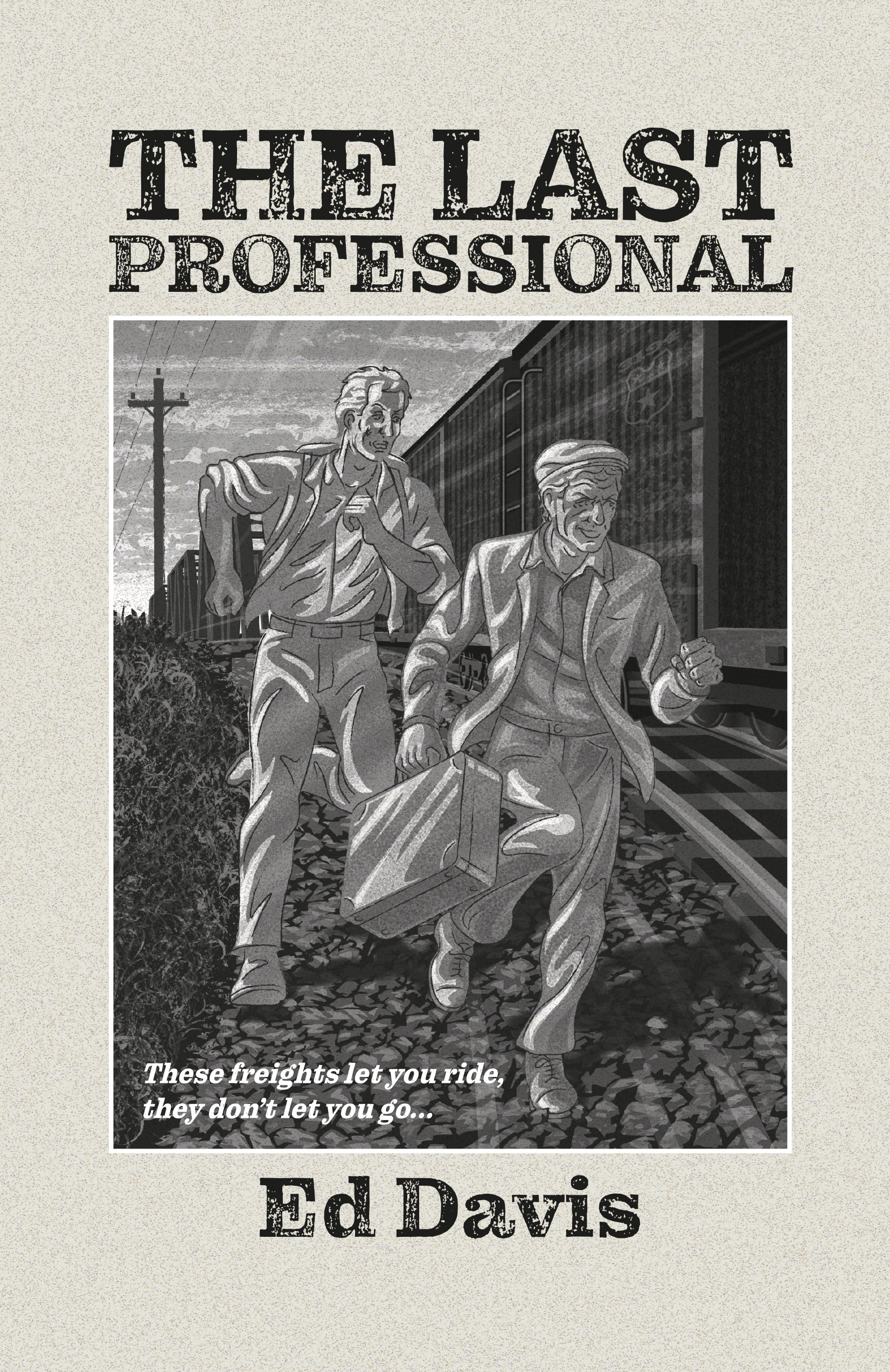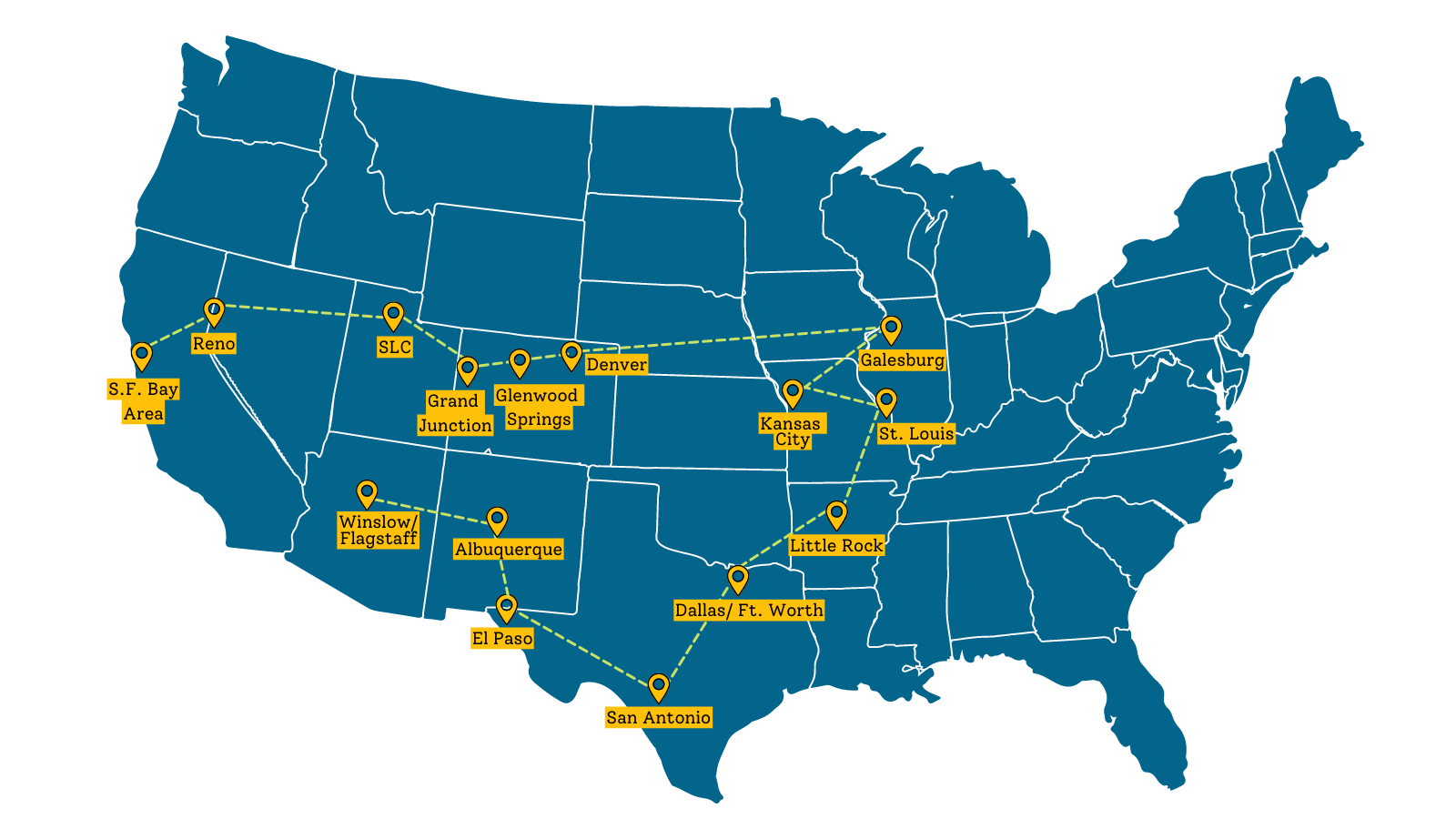Reader’s Guide
The Last Professional
ISBN: 978-1-951122-25-6 (paperback), 978-1-951122-34-8 (ebook), 978-1-951122-40-9 (audio)
Reader’s Guide © 2022 by Ed Davis and Artemesia Publishing
Text Copyright © 2022 by Ed Davis
Cover and Interior Illustrations © 2022 by Colin Elgie
Author’s Note
“You had me at Steinbeck.”
That is my favorite quote so far about THE LAST PROFESSIONAL. It came from a bookseller in Colorado, just after I’d finished a round of “Books & Brews” presentations—essentially speed dating between authors and booksellers—at the Mountains and Plains Booksellers conference. There were a dozen tables full of bookstore owners in a big banquet hall, and I was one of a dozen authors moving from table-to-table giving four-minute presentations to each. Actually, it was a lot like talking to book clubs—something I love to do—only at high speed!
One of the quotes I shared in those presentations was from the founder of the Beat Museum in San Francisco. He said: “With THE LAST PROFESSIONAL, Davis has done for American railroads what Kerouac did for American highways, and Steinbeck did for American nomads.” I was relaxing afterward, actually drinking a brew and catching my breath, when a bookseller I’d presented to sat down next to me and said, “You had me at Steinbeck.”
She went on to explain that she longed for more books like those she grew up with, classic American novels from the likes of Harper Lee, Ernest Hemingway, Marjorie Kinnan Rawlings, and her favorite, John Steinbeck. Novels she could… settle into. “Your book sounds exactly like one of those,” she said. She made my day.
If this is the sort of reading experience you enjoy, I’ve put together the following reader’s guide to help you go a little deeper, to travel a little farther with Lynden and The Duke, and perhaps to see how their experiences might resonate with your own. I hope you will accept my invitation to come along and ride this train!
Ed
A Story Told Four Ways
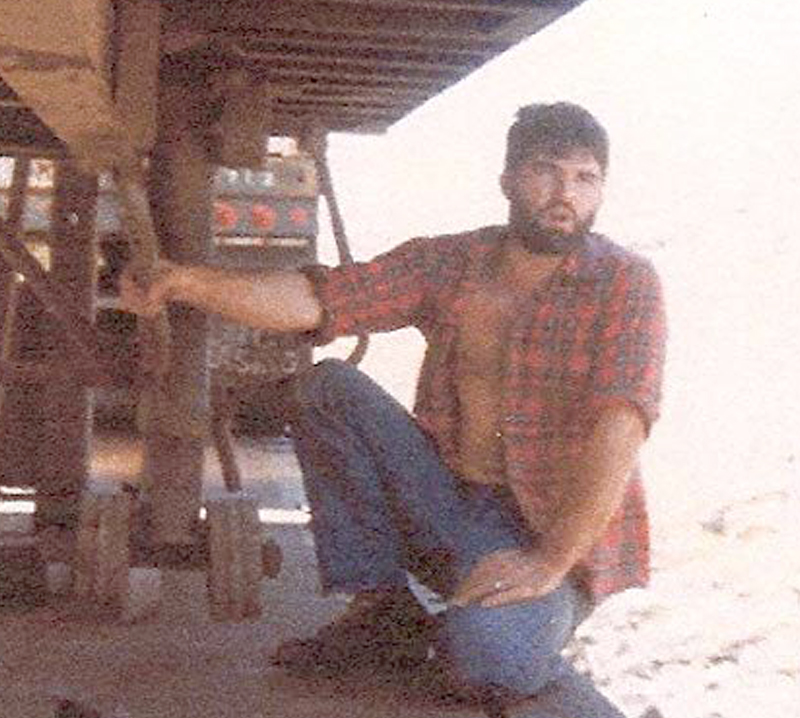 THE LAST PROFESSIONAL is set against a backdrop that I know well from my time riding freight trains around the country in my youth. An older man, near the end of his days, sees his way of life and the code he follows in danger of disappearing. A younger man, on the brink of a new beginning, cannot embrace it without confronting the traumas of his past. And a maniac is intent on destroying them both. Bonds are formed, secrets exposed, sacrifices made, trusts betrayed; all against a breathtaking American landscape of promise and hardship. Three unforgettable characters, hurtling toward a spellbinding climax where pasts and futures collide, and lives hang in the balance.
THE LAST PROFESSIONAL is set against a backdrop that I know well from my time riding freight trains around the country in my youth. An older man, near the end of his days, sees his way of life and the code he follows in danger of disappearing. A younger man, on the brink of a new beginning, cannot embrace it without confronting the traumas of his past. And a maniac is intent on destroying them both. Bonds are formed, secrets exposed, sacrifices made, trusts betrayed; all against a breathtaking American landscape of promise and hardship. Three unforgettable characters, hurtling toward a spellbinding climax where pasts and futures collide, and lives hang in the balance.The world these characters inhabit is so rich with sensation, emotion, and tradition—poetry and peril—that in order to make your reading experience as immersive as possible, I am bringing you the story four ways… you might think of them as four different cars on the same train, all traveling down the same track together, all leading to the same destination, yet each contributing something unique to the journey. They are:
The Epigraphs: Each chapter begins with an epigraph, a bit of hobo poetry that sets the emotional tone and contributes to the narrative. I can almost hear Virginia Slim reciting these verses over the sound of a crackling jungle fire.
The Narrative: Words burst from Thomas Wolfe’s pen in torrents, Hemingway “opened a vein and bled,” and toward the end of his career, F. Scott Fitzgerald struggled to write a single good sentence a day. Three masters of narrative, three completely different approaches to it. I hope you will enjoy the narrative that I have forged in the crucible of my own experience to open a door onto a new world for you to explore and enjoy.
The Tracks: Following most of the chapters in this book there are short sections called Tracks. Each begins with a common term used by The Knights of the Road, followed by some dialogue between two unidentified men speaking around a hobo jungle fire.
The Illustrations: Colin Elgie’s seventeen original compositions herald the return of art quality illustration to adult fiction. Reminiscent of Rockwell Kent, Elgie infuses each black and white portrayal with his fifty years’ experience, from Led Zeppelin and Pink Floyd album covers to the reissues of Victor Canning’s classic Mr. Finchley novels.
Is Every Story a Road Story?
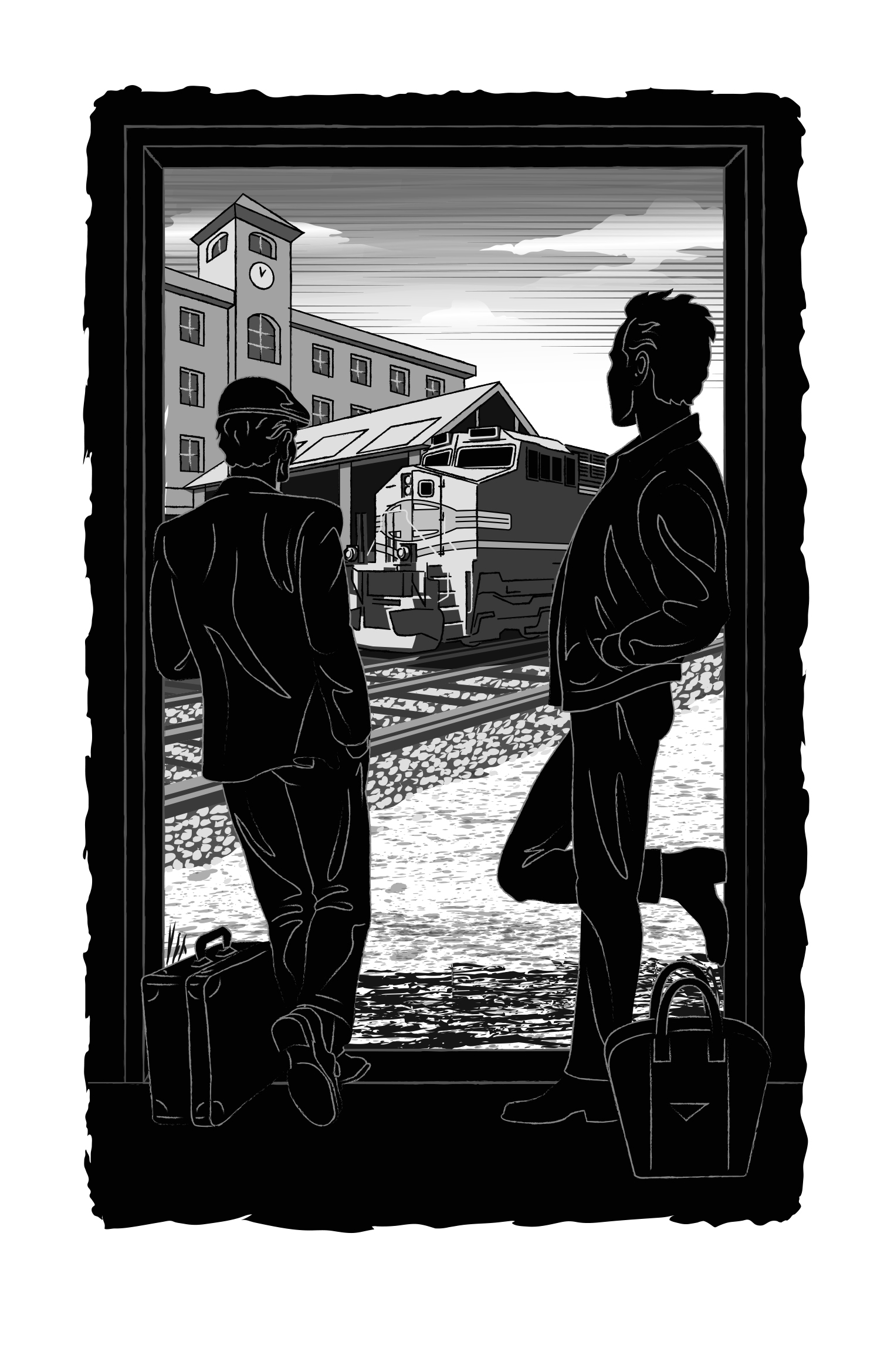
Many of our best and oldest yarns are about travel, going all the way back to legend. All of us are on our own hero’s journey—one with a beginning, middle, and end—just like a good road story. We speak of taking the high road, the low road, the road less traveled. Whether we are on the road to redemption or ruin, just like Lynden and The Duke we are on the road, even if we never leave our homes.
All our stories have a common start at birth, but the stories and journeys that define us are as unique as we are.
Though the events in The Last Professional transpire over several weeks one summer in the 1980’s where did the defining stories of the main characters begin?
Q: When did Lynden’s defining story start? Was it in Auburn, Washington as a boy, or with his promotion at Data Dynamics?
Q: By his own admission The Duke is near the end of his own journey having traveled the rails for over 40 years. Did The Duke’s defining story begin when he left The Cumberland Valley to ride the rails, or when he entered the Colton jungle? Or somewhere else?
Q: Short Arm’s own story wasn’t too different from The Duke’s, at least for part of the journey. Did Short Arm’s defining journey begin the first time he wore the fist-shaped buckle, or with the loss of his arm, or with his release from the mental hospital?
Regardless of how they began, in the pages of this book their stories merge and effect one another’s in ways none of them anticipated, towards destinations none of them could foresee.
Q: As you were reading, were you able to foresee where these stories would go?
Q: If you had to identify your own defining story, or one of them, what would it be? In reading, and in life, do you attempt to foresee the conclusion, or prefer to experience events as the journey unfolds?
Worlds Hidden in Plain Sight
There are dramas unfolding around us constantly, struggles for identity, safety and survival that go unnoticed—not necessarily out of indifference, but because we are unable to recognize what we aren’t looking for.
The Last Professional takes place in a hidden world that is no farther away than the nearest railroad track, no less visible than the slow-moving freight that sometimes delays you at a railroad crossing.
Q: Have you ever looked at a passing freight train and wondered if someone might be riding it? Have you ever seen someone riding? What do you think about the person you see, or that you imagine, riding that train?
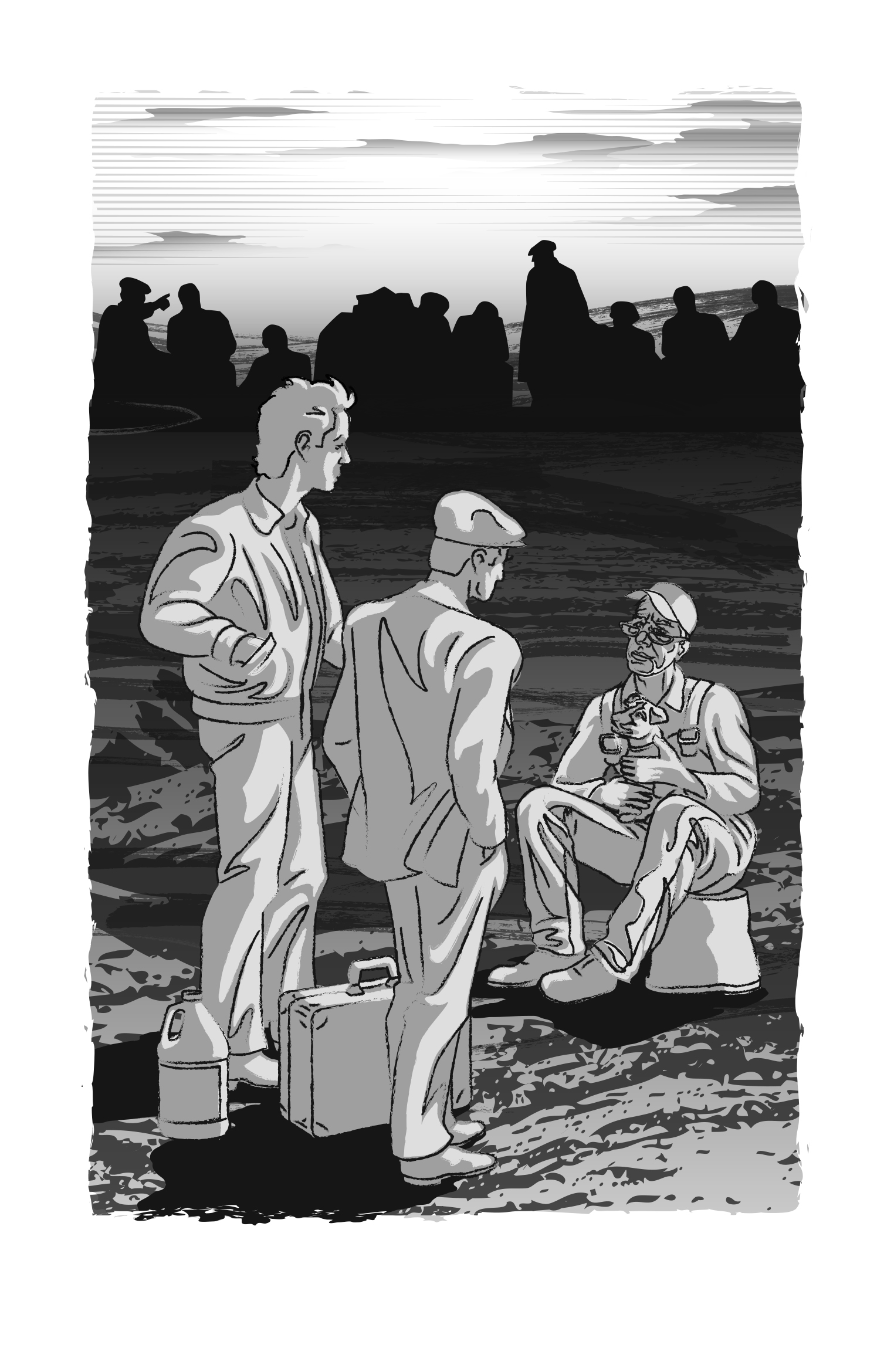 Q: Hundreds of thousands of people took to the road during the Great Depression, many of them riding the rails. Do you have family stories of a grandfather or grandmother, an uncle, or a cousin who was once a Knight of the Road, or knew one?
Q: Hundreds of thousands of people took to the road during the Great Depression, many of them riding the rails. Do you have family stories of a grandfather or grandmother, an uncle, or a cousin who was once a Knight of the Road, or knew one?
Hobos were journeymen of manual labor, honing skills that could find them a job anywhere there was work to be done, work that was often invisible. Lynden and The Duke work for a time with a traveling carnival, and enter a world that patrons never see.
Q: The Duke easily fits into the world of the carneys while Lynden is reluctant about what he’s required to do. Does this say anything about their character? Does it necessarily make either character better, or worse, than the other?
Q: Lynden observes the carneys rigging many of the games. Have you played carnival games, and wondered if they were on the level, or rigged? Should people attending a carnival just expect the games to be rigged, “caveat emptor”? What does this tell us about a society where this sort of behavior, if not accepted, is often overlooked?
Q: Are you intimate with a world—hidden in plain sight—that most of us miss because we don’t know how to recognize it? Is it a world you want to share, or would sharing it diminish its appeal?
Paying It Forward
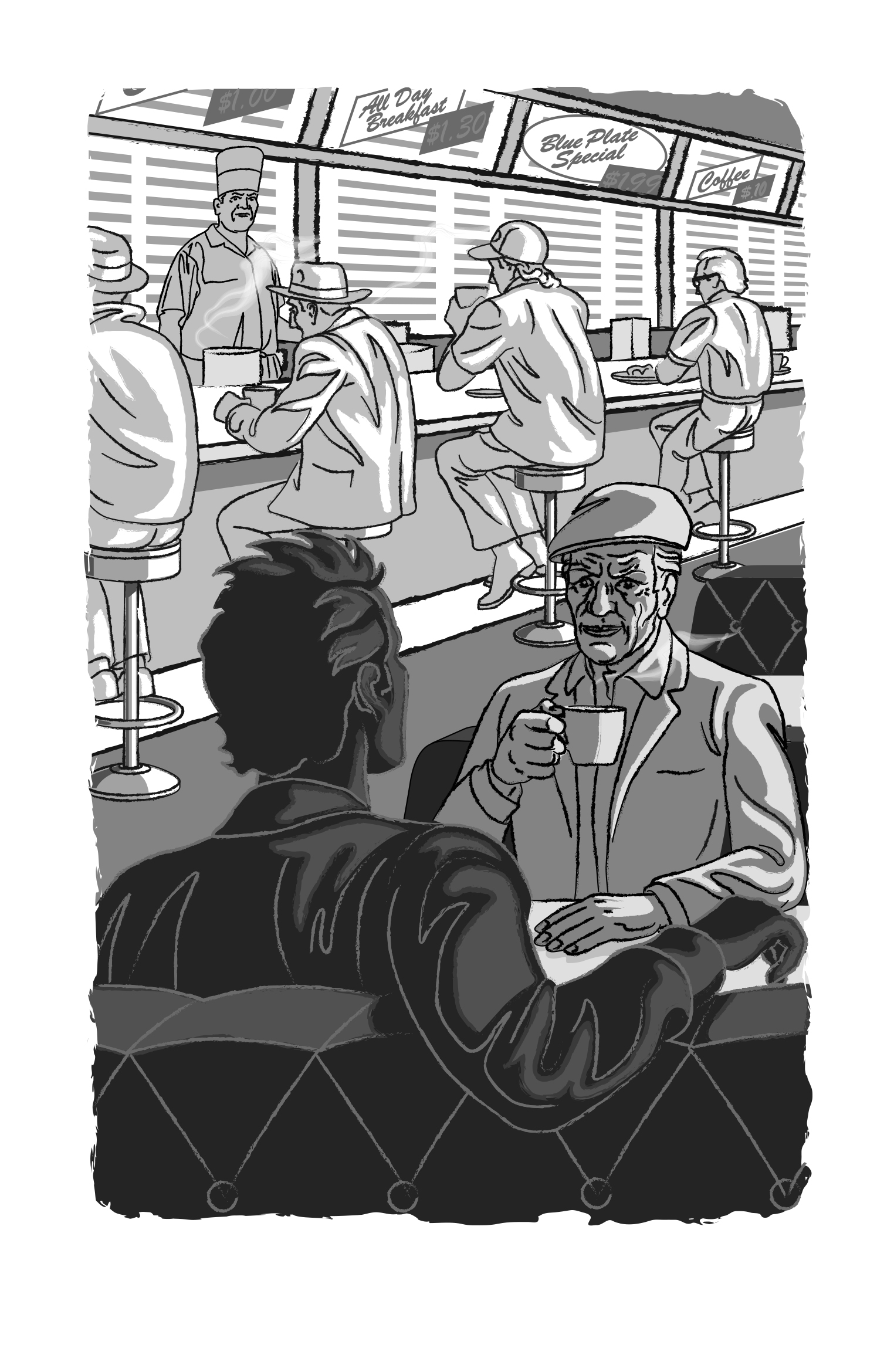 Article #14 of The Hobo Code of Ethics, drafted at the St. Louis National Hobo Convention in 1889, states: “Help your fellow hobos whenever and wherever needed, you may need their help someday.” It is the hobo version of The Golden Rule—mentoring, hobo-style.
Article #14 of The Hobo Code of Ethics, drafted at the St. Louis National Hobo Convention in 1889, states: “Help your fellow hobos whenever and wherever needed, you may need their help someday.” It is the hobo version of The Golden Rule—mentoring, hobo-style.
In the story, The Duke tells Lynden, “You always share in a jungle. No matter how little you got, if some other hobo’s there, you share with him. He’ll share back.”
Q: Does “paying it forward” necessarily mean an actual physical payment of some kind—like the sharing of food—or can it be done in other ways? What are some ways that you have “paid it forward” in your own life?
Q: When does the relationship between Lynden & The Duke shift from that of wary but respectful strangers to mentor/mentee?
Q: What are The Duke’s motives for showing Lynden the ropes? Do these motives change over the course of the novel? Does The Duke have any ulterior motives for helping Lynden?
Q: What are Lynden’s motives for wanting to learn from The Duke? Do they change?
Q: In your own life, have you been a mentor? Have you been mentored? What were the personal rewards of those relationships? What were the personal costs?
Throwing The Switch
One of the first questions Lynden asks The Duke, when they have only just met, is “Where’s this train heading, do you know?” The Duke replies, “Wherever the hell she takes us. If she swings north up here, then it’s Dunsmuir and on to Oregon. If she holds straight east, then it’s over the hump to Reno and Sparks.”
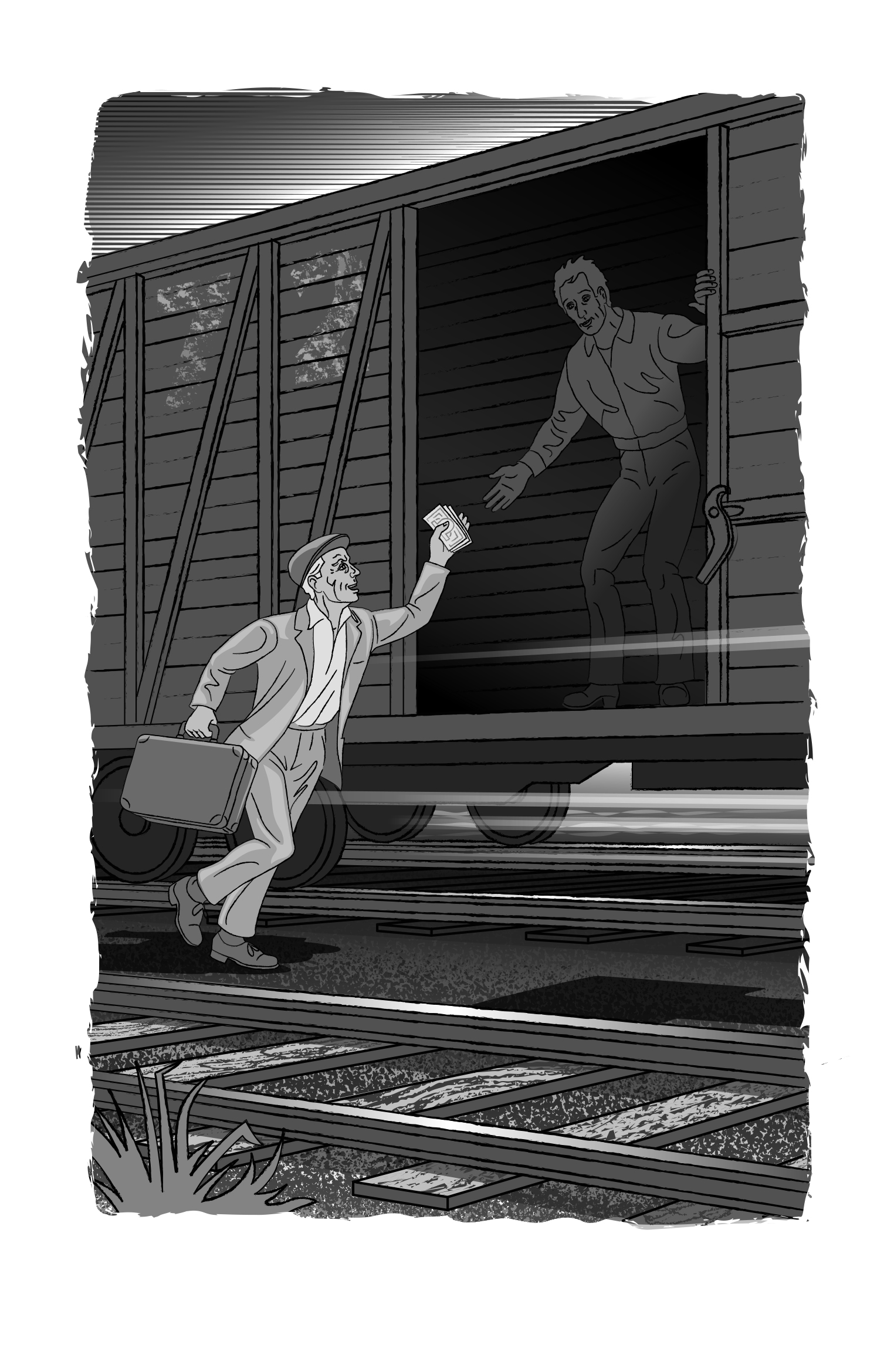 Their journey, and their fate, depends on the throwing of a track switch, a switch over which they have no control. The moveable elements of a switch are actually called ‘points.’ They literally point one way or another. There are several such points for the main characters in this story, choices that will determine what happens next.
Their journey, and their fate, depends on the throwing of a track switch, a switch over which they have no control. The moveable elements of a switch are actually called ‘points.’ They literally point one way or another. There are several such points for the main characters in this story, choices that will determine what happens next.
Q: What motivates Lynden to throw a switch and change direction when he receives the promotion at Data Dynamics?
Q: What motivates The Duke to throw a switch and act after he is stopped in his tracks under the overpass in Sparks?
Q: Were those changes in direction planned, or instinctive? Did Lynden and The Duke have any more control over them than they did over the direction of the train they were riding when they first met?
Q: If such a switch has been thrown in your life, was it motivated by intention, or initiated by instinct? If you could go back and throw that switch again now—and point it in a different direction—would you do so?
Freedom to Roam
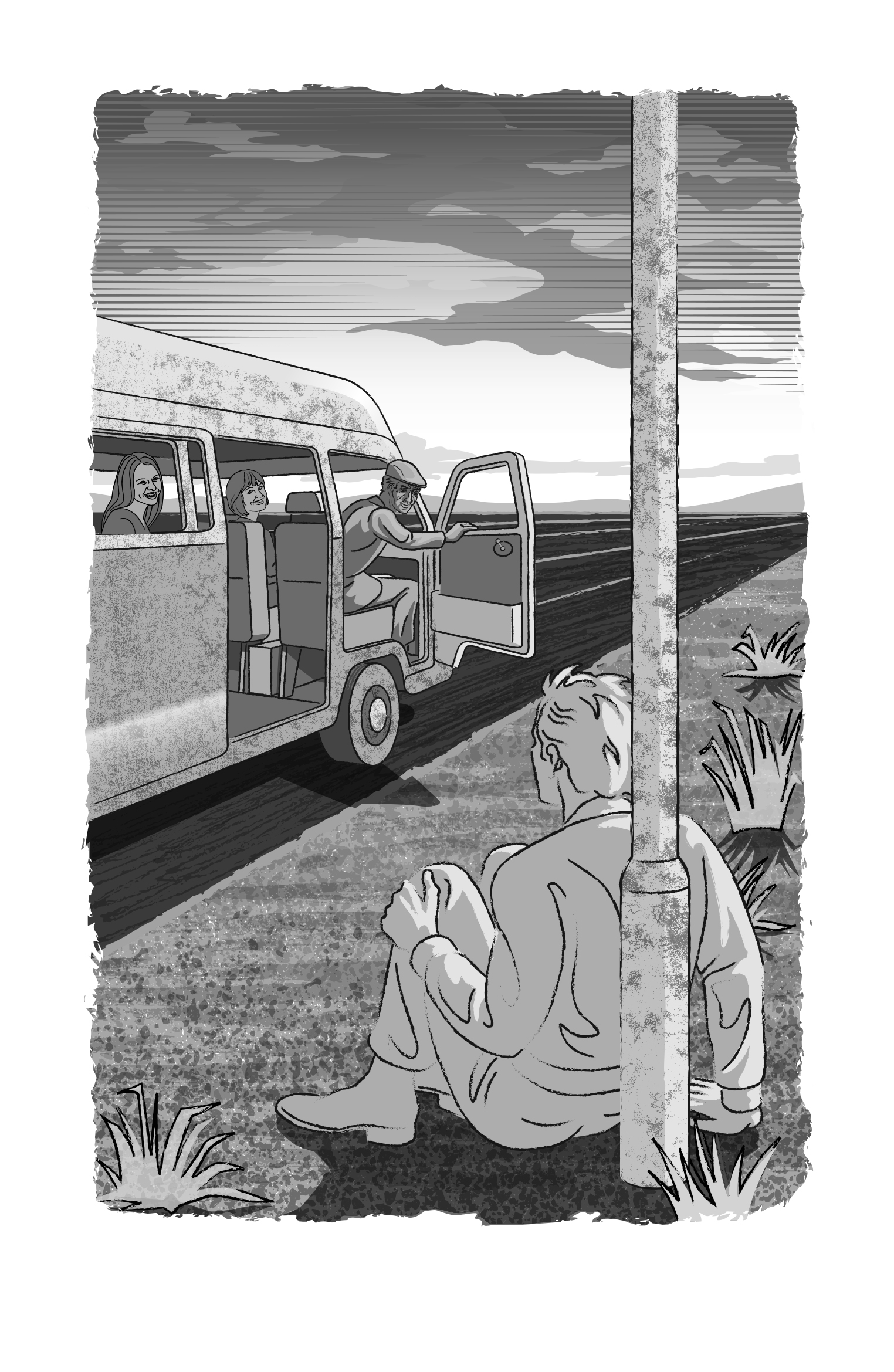 “Us tramps live in a small world,” The Duke tells Lynden at one point, “smaller than you’d believe.” The contradiction that hobos live in a landscape seemingly without confines, yet their paths through that land are forged in steel, is not without parallel. The freedom promised by Mark Twain’s paddle-wheelers was conscribed by the courses of the rivers. Melville’s whalers gazed daily upon horizons without limit yet found themselves captive within the hulls of their ships.
“Us tramps live in a small world,” The Duke tells Lynden at one point, “smaller than you’d believe.” The contradiction that hobos live in a landscape seemingly without confines, yet their paths through that land are forged in steel, is not without parallel. The freedom promised by Mark Twain’s paddle-wheelers was conscribed by the courses of the rivers. Melville’s whalers gazed daily upon horizons without limit yet found themselves captive within the hulls of their ships. Q: Was it wanderlust that drove Profesh—professional hobos—to travel the country by rail, or a desire for mastery of a narrow world defined by rails? Or might there be different motivations?
Q: Is a life without boundaries the ultimate expression of freedom, or a formula for chaos? Is the quest for such freedom selfish, or is surrendering to it selfless?
Q: Are the prescribed paths in our lives comforting, or confining? Can they be both?
Q: Have you ever been in a situation similar to Lynden and The Duke’s, and given freedom to do whatever you wanted? Were you constrained by anything due to that freedom, like the rails constrain the hobos?
Side-door Sanctuaries
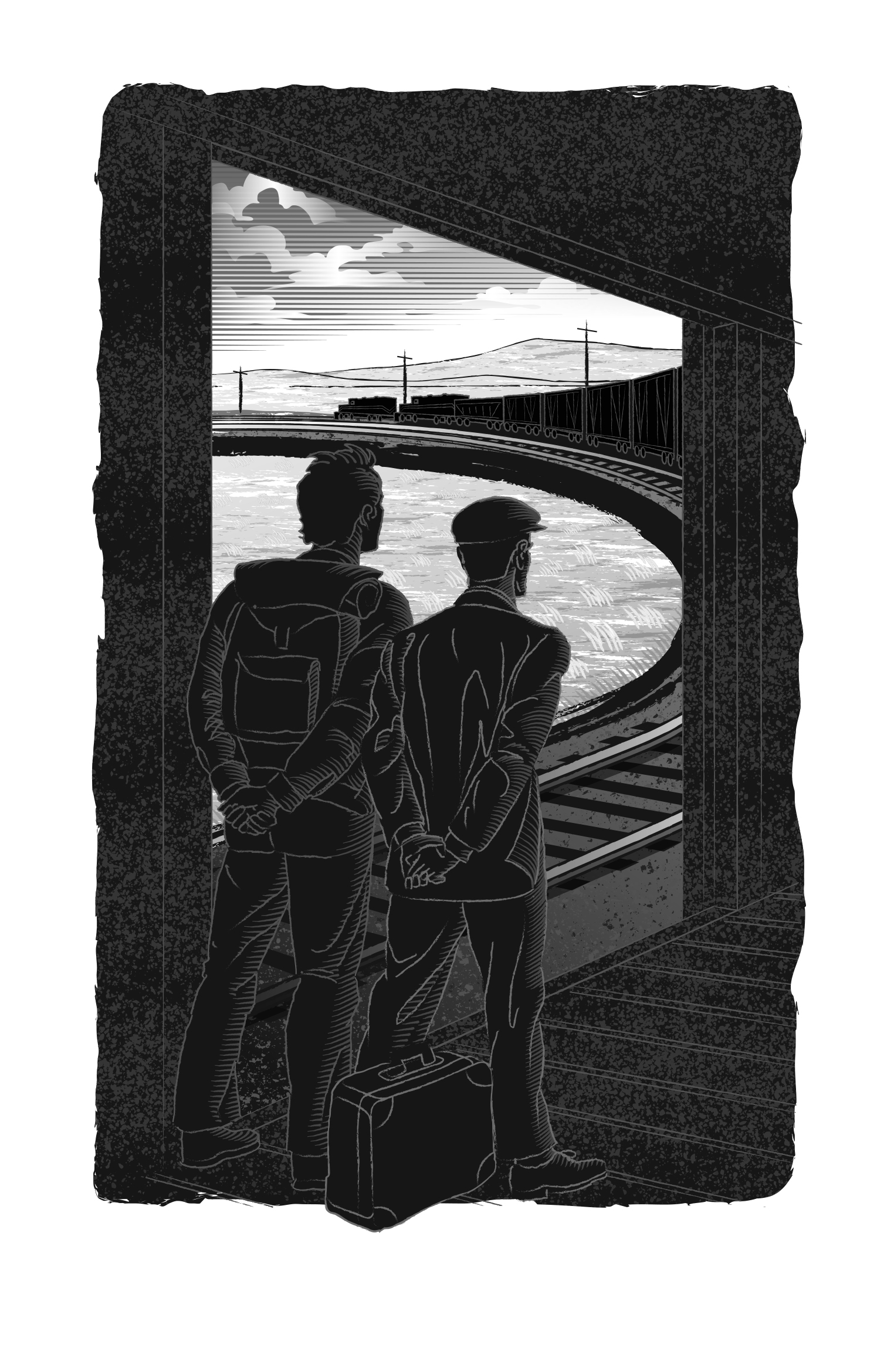 Boxcars, also called “Side-door Pullmans” by The Knights of the Road, were always the preferred ride. Flatcars, with ladders on each end, were easier to catch. Streamliners—passenger trains—were more exciting, and more dangerous. But a boxcar provided shelter from the wind and rain, and from the searching eyes of the railroad bulls whose job it was to keep riders off. It was a rolling home for however long you rode it. If you were sharing it with a friend or riding alone, it could be a safe haven from the perils of the road—a place to rest, and heal, and plan your next move. Or it could be a rolling prison if you got trapped inside with a maniac.
Boxcars, also called “Side-door Pullmans” by The Knights of the Road, were always the preferred ride. Flatcars, with ladders on each end, were easier to catch. Streamliners—passenger trains—were more exciting, and more dangerous. But a boxcar provided shelter from the wind and rain, and from the searching eyes of the railroad bulls whose job it was to keep riders off. It was a rolling home for however long you rode it. If you were sharing it with a friend or riding alone, it could be a safe haven from the perils of the road—a place to rest, and heal, and plan your next move. Or it could be a rolling prison if you got trapped inside with a maniac. Q: When we first meet The Duke he is hiding in the corner of a boxcar as it rolls up the California coast. Was it truly the safest place for him to be, or did it just feel like the safest?
Q: Given Lynden’s first experience in a boxcar as a boy, why does he return to one? If he wanted to catch a train in Roseville, why not catch a different type of car?
Q: Is our personal choice of a safe haven—a sanctuary—more determined by facts or feelings? Is it reality, or perception, that makes us feel safe there? Could any other place make us feel the same?
Catching the Westbound
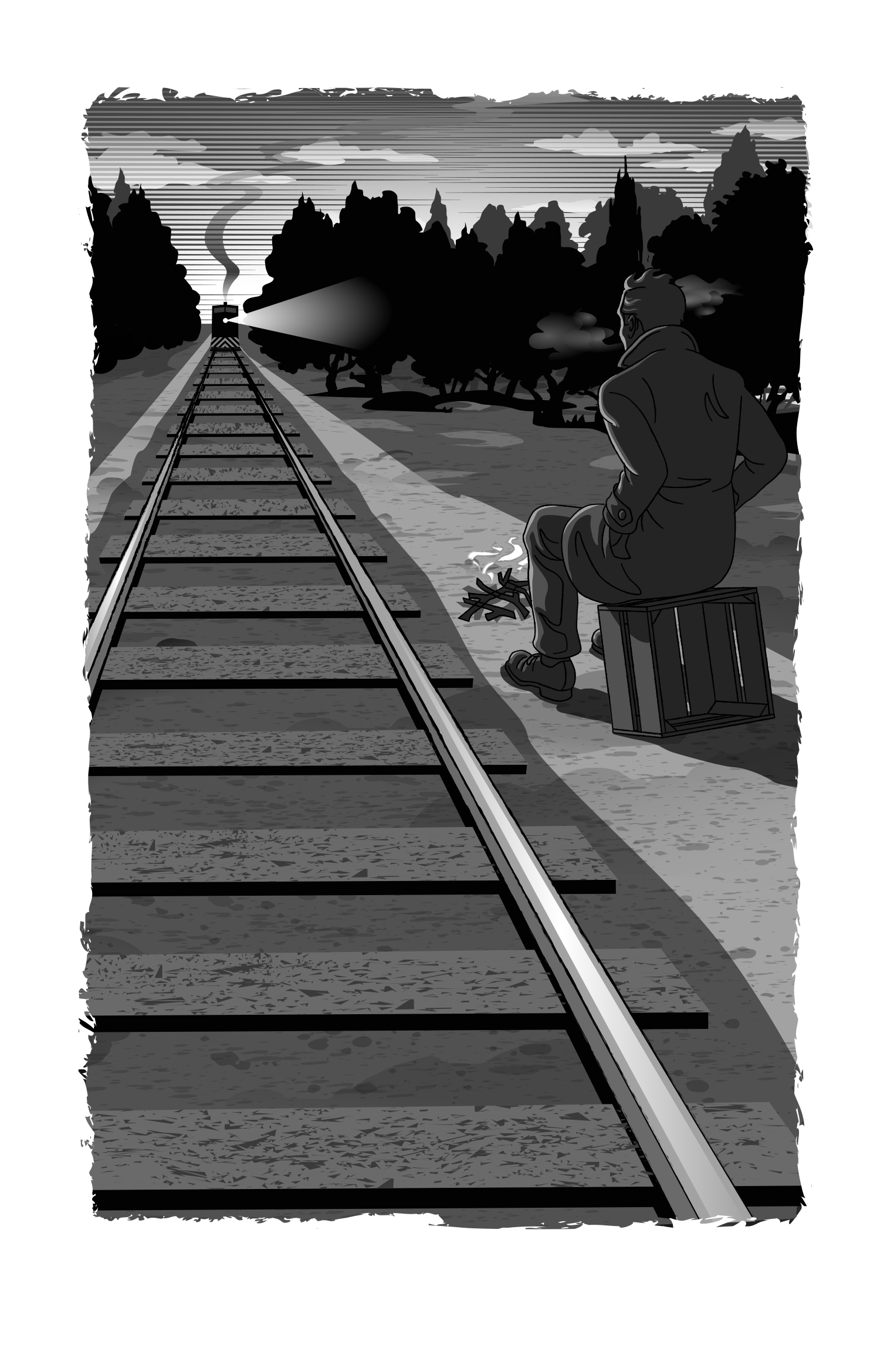 Just as all our stories share a common beginning at birth, they all share a common end. Native American legend speaks of walking west at the end of life, the elves in The Lord of the Rings—and a few others—sail into the west. Hobos, when their riding days are done, Catch the westbound. Each implies that a journey is ending but is not yet over.
Just as all our stories share a common beginning at birth, they all share a common end. Native American legend speaks of walking west at the end of life, the elves in The Lord of the Rings—and a few others—sail into the west. Hobos, when their riding days are done, Catch the westbound. Each implies that a journey is ending but is not yet over.Q: Are there other euphemisms that are used for death that you have heard? Do you think it’s good to talk about death in this way? Why or why not?
It was the Roman philosopher Seneca who famously said, “Every new beginning comes from some other beginning’s end.”
After you’ve turned the final page of The Last Professional, ask yourself:
Q: Which stories have ended?
Q: Which are not yet over?
Q: Which are just beginning?
Q: Can you identify any of your own stories that might have ended, are still being told, or might just be beginning?
In The Return of the King, by J.R.R. Tolkien, when Pippin thinks the end is near, Gandalf replies:
“End? No, the journey doesn’t end here. Death is just another path, one that we all must take. The grey rain-curtain of this world rolls back, and all turns to silver glass, and then you see it—white shores, and beyond, a far green country under a swift sunrise.”
Q: If you had to paint a picture of what awaits a hobo once they catch the westbound, what would it be?

